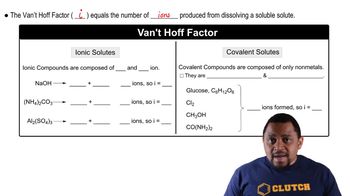Here are the essential concepts you must grasp in order to answer the question correctly.
van't Hoff Factor (i)
The van't Hoff factor (i) is a measure of the number of particles into which a solute dissociates in solution. For ionic compounds like KCl, which dissociates into K+ and Cl- ions, the van't Hoff factor is typically 2. This factor is crucial for calculating colligative properties, such as vapor pressure depression, as it directly influences the extent of these properties based on the number of solute particles present.
Recommended video:
Vapor Pressure Depression
Vapor pressure depression occurs when a non-volatile solute is added to a solvent, resulting in a decrease in the solvent's vapor pressure. This phenomenon is a colligative property, meaning it depends on the number of solute particles rather than their identity. The extent of vapor pressure depression can be calculated using Raoult's Law, which relates the vapor pressure of the solution to the mole fraction of the solvent.
Recommended video:
Raoult's Law and Vapor Pressure
Raoult's Law
Raoult's Law states that the vapor pressure of a solvent in a solution is equal to the vapor pressure of the pure solvent multiplied by its mole fraction in the solution. This law is fundamental in understanding how the addition of solute affects the vapor pressure of the solvent. In the context of the question, it allows for the calculation of the van't Hoff factor by relating the observed vapor pressure depression to the concentration of the solute.
Recommended video:
Raoult's Law and Vapor Pressure
 Verified step by step guidance
Verified step by step guidance

